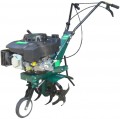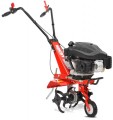Working width
The maximum width of the strip of land processed by the machine in one pass.
The large width makes it easier to work in large open areas, allowing them to be dealt with faster. At the same time, it is easier to deal with bottlenecks and hard-to-reach nooks and crannies with a small working width — a large unit may simply not fit where a smaller one will pass without problems. So it is worth choosing according to this indicator, taking into account the features of the planned work. If we talk about specific numbers, then in the smallest models the capture width
does not exceed 50 cm, in the largest it can be
1 m or more, a value
from 50 to 75 cm can be called average, and
from 75 cm to 1 m — above average.
Also note that some models allow you to expand the processing width by installing additional cutters. However, note that the wider the band, the more power is needed for efficient operation. It is believed that for the full use of the two-wheel tractor, it must produce at least 1 hp. for every 20 cm of width; however, for loose soils and shallow depths, smaller values are sufficient.
Working depth
The maximum processing depth provided by the unit. In cultivators with non-replaceable cutters, this parameter is determined primarily by the cutter diameter, in walk-behind tractors designed for active cutters (see below) - by design features (in such models, even high power does not guarantee a large working depth). The most limited indicator in modern walk-behind tractors is
up to 20 cm, and a value
from 21 to 25 cm can be called small. However, often even such capabilities are quite sufficient. A depth of
26 to 30 cm already provides quite extensive capabilities, and the most advanced models are capable of "biting into the ground"
more than 30 cm.
In any case, the optimal processing depth depends on the type and condition of the soil, as well as the crops for which the soil is being prepared; detailed recommendations on this matter can be found in specialized sources. So it does not always make sense to look for a model with maximum depth - especially since such capabilities require high power. It should also be noted that in many units the depth can be adjusted.
Reducer
The type of gearbox provided in the design of the two-wheel tractor.
The gearbox is a mechanism for transmitting rotation from the motor shaft to the working shaft; the speed of rotation is reduced, and the tractive effort, respectively, increases. In modern units,
worm,
chain,
gear and
gear-chain gearboxes can be used; here are their main features:
— Worm. Gearboxes based on a worm gear are mainly used in light two-wheel tractors with passive cutters (motor cultivators). With simplicity and low cost, such a gearbox provides a high gear ratio, which makes it possible to achieve good traction at a relatively low engine power. Other advantages of worm gears include compactness, minimum noise level, smooth running and self-braking ability. On the other hand, such gearboxes do not tolerate high loads, which determined the scope of their application.
— Chain. Gearboxes based on a chain drive — two gears connected by a chain (similar to the mechanism used in bicycles). Such gearboxes are somewhat more expensive than worm gears, but they are more reliable and able to work with higher loads. Another advantage lies in the small width of the body, which is especially important for motor cultivators — the gearbox does not limit the depth of processing, since it can be buried in the soil simultaneously with the cutters.
...— Geared. The most advanced type of modern gearboxes. Such mechanisms are highly reliable and durable, they normally endure long-term work at high loads. The downside of these advantages is the high price. Gear reducers are used mainly on professional equipment, for which "endurance" is critical.
— Gear-chain. A compromise option, which, when installed on a motor cultivator, increases its performance (compared to chain and worm), and when installed on a motor block, slightly reduces the cost of the latter.Motor model
Model of the engine installed in the two-wheel tractor / cultivator. The main performance data of the engine is usually indicated in the general data for the unit. However, knowing the exact name of the motor, you can find more detailed information on it — starting from specific data like torque or revolutions and ending with reviews and reviews. Also, data on the engine model can be useful when searching for spare parts or consumables.
Engine size
The working volume of the gasoline or diesel engine of the cultivator / two-wheel tractor. For an internal combustion engine of the same type (see "Type of internal combustion engine"), power and fuel consumption usually directly depend on the volume. Also, the classification of a two-wheel tractor as a vehicle according to the traffic rules of a particular country may depend on the engine volume; you should pay attention to this if you plan to use the unit as a tractor and drive on roads.
Motor power
Horsepower of two-wheel tractor/cultivator motor. The basic unit of power nowadays is watt, however for petrol and diesel engines (see "Motor type") the more traditional designation in horsepower is often used. 1 hp is approximately equal to 735 watts.
More powerful motor allows achieving higher productivity, width and depth of processing. On the other hand, high power significantly affects the price, weight and dimensions of the unit, as well as the consumption of electricity/fuel. In light of this, the engine characteristics are selected by the manufacturer taking into account what "weight category" the walk-behind tractor belongs to. The most limited modern units have a power of
up to 2 hp, in the heaviest and most advanced this figure can
exceed 13 hp ;
4 - 7 hp can be called an average indicator, and
2 - 4 hp and
7 - 13 hp are below and above average, respectively.
Detailed recommendations on the optimal power for a given situation can be found in specialized sources.
Motor power
The power of the two-wheel tractor/cultivator engine in watts. This designation is usually used for electric engines, but can also be used for petrol/diesel engines, along with horsepower (for more information, see the "Motor power" section above).
More powerful motor allows achieving higher productivity, width and depth of processing. On the other hand, high power significantly affects the price, weight and dimensions of the unit, as well as the consumption of electricity / fuel. In light of this, the engine power is selected by the manufacturer taking into account what "weight category" the walk-behind tractor belongs to, what characteristics it should show. So, the lightest models have a power
of up to 1.5 kW, this is the device that is best suited for a small area of 6 - 8 acres. Walk-behind tractors
up to 3 kW can cope with 10 - 15 acres, a power of
3.5 - 5 kW is suitable for a plot of 50 acres to a couple of hectares. Units
for 5 - 10 kW are already classified as professional level, they can "tame" spaces of 7 - 10 hectares; and the heaviest and most powerful modern walk-behind tractors have a power
of more than 10 kW.
Fuel tank volume
The volume of the fuel tank of the cultivator / two-wheel tractor; knowing this parameter and fuel consumption (see above), it is possible to determine the maximum operating time of the unit on a single refill. If you plan to use the device in large areas or to work for a long time, it makes sense to look for a model with a large tank — it will not have to be filled often. On the other hand, for short-term work in small areas, a large tank is not required — in this case, it only increases the weight and dimensions of the unit.
Crankcase oil capacity
The nominal volume of oil in the crankcase, in other words, is the amount of oil that must be in the engine for its normal operation. This parameter is relevant mainly for four-stroke units (see "Type of internal combustion engine") — in two-stroke units, usually, gasoline and oil are poured in the form of a mixture, and there is no separate container for lubrication. Certain deviations from this volume are allowed, but in general they are undesirable.

